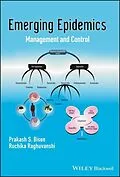A global perspective on the management and prevention of
emerging and re-emerging diseases
Emerging infectious diseases are newly identified or otherwise
previously unknown infections that cause public health challenges.
Re-emerging infectious diseases are due to both the reappearance of
and an increase in the number of infections from a disease that is
known, but which had formerly caused so few infections that it was
no longer considered a public health problem. The factors that
cause the emergence or re-emergence of a disease are diverse.
This book takes a look at the world's emerging and re-emerging
diseases. It covers the diagnosis, therapy, prevention, and control
of a variety of individual diseases, and examines the social and
behavioral issues that could contribute to epidemics. Each chapter
focuses on an individual disease and provides scientific background
and social history as well as the current basics of infection,
epidemiology, and control.
Emerging Epidemics: Management and Control offers five
topics of coverage:
FUNDAMENTALS
* Epidemics fundamentals
* Disasters and epidemics
* Biosafety
RE-EMERGING EPIDEMICS
* Tuberculosis
* Plague
NEWLY EMERGING EPIDEMICS
* Leptospirosis
* Dengue
* Japanese Encephalitis
* Chikungunya Fever
* West Nile Virus
* Chandipura Virus Encephalitis
* Kyasanur Forest Disease
* Hantavirus
* Human, Avian, and Swine Influenza
* Severe Acute Respiratory Syndrome
* Nipah Virus
* Paragonimiasis
* Melioidosis
POTENTIAL EPIDEMICS
* Biowarfare and bioterrorism
* Food contamination and food terrorism
* Antimicrobial resistance
VECTOR CONTROL METHODS
* Mosquito control
* Other disease vectors and their control
Offering an integrated, worldwide overview of the complexity of
the epidemiology of infections, Emerging Epidemics will be a
valuable resource for students, physicians, and scientists working
in veterinary, medical, and the pharmaceutical sciences.
Autorentext
Prakash Singh Bisen, PhD, D.Sc, is an eminent scientist in the field of Biotechnology with over 32 years of research and teaching experience. He has one US Patent and an Indian Patent on Tuberculosis to his credit. He is also an author of over 130 research publications. Presently, Professor Bisen is the Chairman of Bisen Biotech and Biopharma (P) Ltd. a private equity venture which focuses on diagnostic solutions for widespread diseases. Professor Bisen is also the Chairman of the Vikrant Group, which focuses on advancing technical education through technical institutes at Gwalior and Indore, India.
Ruchika Raghuvanshi, PhD, is a Research Scientist at the Defence Research Development Organization, a division of the Indian Ministry of Defence.
Vijayaraghavan, PhD, is Director of the Defence Research Development Establishment, the Defence Research Development Organization, a division of the Indian Ministry of Defence.
Zusammenfassung
A global perspective on the management and prevention of emerging and re-emerging diseases
Emerging infectious diseases are newly identified or otherwise previously unknown infections that cause public health challenges. Re-emerging infectious diseases are due to both the reappearance of and an increase in the number of infections from a disease that is known, but which had formerly caused so few infections that it was no longer considered a public health problem. The factors that cause the emergence or re-emergence of a disease are diverse.
This book takes a look at the world's emerging and re-emerging diseases. It covers the diagnosis, therapy, prevention, and control of a variety of individual diseases, and examines the social and behavioral issues that could contribute to epidemics. Each chapter focuses on an individual disease and provides scientific background and social history as well as the current basics of infection, epidemiology, and control.
Emerging Epidemics: Management and Control offers five topics of coverage:
FUNDAMENTALS
- Epidemics fundamentals
- Disasters and epidemics
- Biosafety
RE-EMERGING EPIDEMICS
- Tuberculosis
- Plague
NEWLY EMERGING EPIDEMICS
- Leptospirosis
- Dengue
- Japanese Encephalitis
- Chikungunya Fever
- West Nile Virus
- Chandipura Virus Encephalitis
- Kyasanur Forest Disease
- Hantavirus
- Human, Avian, and Swine Influenza
- Severe Acute Respiratory Syndrome
- Nipah Virus
- Paragonimiasis
- Melioidosis
POTENTIAL EPIDEMICS
- Biowarfare and bioterrorism
- Food contamination and food terrorism
- Antimicrobial resistance
VECTOR CONTROL METHODS
- Mosquito control
- Other disease vectors and their control
Offering an integrated, worldwide overview of the complexity of the epidemiology of infections, Emerging Epidemics will be a valuable resource for students, physicians, and scientists working in veterinary, medical, and the pharmaceutical sciences.
Inhalt
Preface xv
Acknowledgments xvii
Chapter 1 Prologue 3
Introduction 3
Causative Factors 7
Salient Features 11
Emerging Epidemics 11
Re-Emerging Epidemics 17
Antimicrobial Resistance 18
Public Health Implications 20
References 22
Chapter 2 Epidemics Fundamentals 24
Introduction 24
Definitions 24
Types of Epidemics 26
Epidemiological Triad 29
Forecasting an Epidemic 31
Contingency Plan 33
Investigation of Epidemics 35
Management of Epidemics 38
Control of Epidemics 39
Principles of Planning Emergency Services 41
References 44
Chapter 3 Disasters and Epidemics 46
Fundamentals 46
Contributory Factors 51
Investigation of Rumors 52
References 54
Chapter 4 Biosafety 56
Introduction 56
Components 57
Hand Washing 61
Preventing Needlestick Injuries 62
Safe Transport of Biological Material 64
Safe Decontamination of Spills 65
Safe Handling of Dead Bodies 67
Personal Protective Equipment 69
Management of Biomedical Waste 69
Infection Control Check List 71
Biosafety Levels 71
Accreditation of Hospitals and Laboratories 74
References 75
Chapter 5 Tuberculosis 76
History 76
Magnitude 78
Agent Factors 81
Host Factors and High-Risk Groups 88
Environmental Factors 89
Modes of Transmission 90
Pathology and Immunology 91
Clinical Manifestations 96
Diagnosis of Tuberculosis 101
Directly Observed Treatment, Short Course (DOTS) 119
Tuberculosis and HIV 135
Drug-Resistant Tuberculosis 140
Prevention and Control 142
Social and Cultural Factors 145
References 148
Chapter 6 Plague 154
History of Plague 154
Magnitude 155
Agent Factors 157
Host Factors 158
Environmental Factors 159
Reservoir 159
Mode of Transmission 160
Clinical Manifestations 161
Laboratory Diagnosis 164
Differential Diagnosis 170
Clinical Management 170
Prevention and Control 172
References 174
Chapter 7 Leptospirosis 176
Introduction 176
Magnitude 176
Agent Factors 177
Host Factors 179
Environmen…
